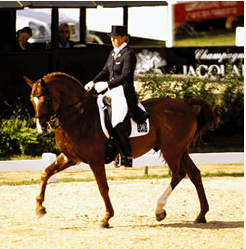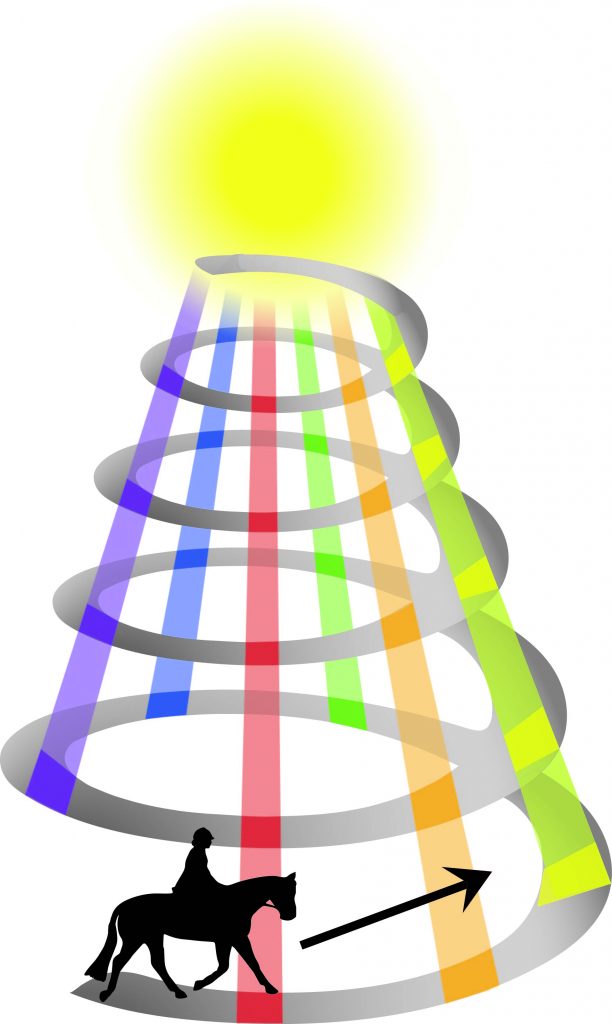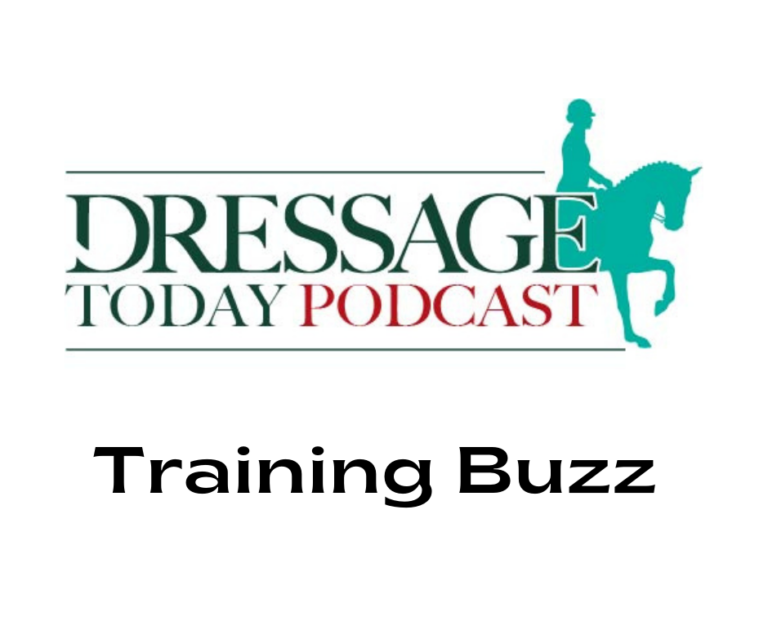When riding a balanced horse, I feel as if it is soft and easy—I don’t have to do anything. I don’t need to do anything because I am one with the horse—as if we are dancing a seamless waltz.

On the other hand, if a horse is unbalanced, he’s like a drunken person who can’t walk a straight line because he does not have control of his step. Similarly, an unbalanced horse doesn’t have control of the length of his step or the speed of it, and therefore, he is sometimes wobbly, too. In addition to not wanting to have a wobbly horse, you want to balance your horse so he can bear more weight on his hind legs and use more of his muscles instead of his tendons and joints—the purpose of dressage.
The key to balancing your horse is to first ask him to take smaller steps. If I walk on a road and suddenly come to an icy patch, I lose my balance if I continue to walk as if I was on firm ground. After awhile, I learn that when it’s icy, I need to take small steps to keep my balance and avoid falling on my nose. Likewise, when a horse has problems with balance, you need to be able to influence him to take smaller steps. Eventually, at the same time, you will give the horse freedom in front, allowing him to find his own balance. This is the basis of collection.
Unfortunately, the most common advice I hear from ringside trainers is, “Use more leg, and ride more forward!” If a rider uses more leg and the horse takes longer steps, the horse will lose his balance even more. The rider can improve the horse’s balance by asking for shorter, smaller strides. But in order to do this, the rider first must have a solid position so the horse can’t push him out of balance. The rider also needs to make sure the horse will stop from his rein aids and go from his leg aids, so that the rider can make effective half halts. Only by making effective half halts can the rider ask the horse to take shorter steps. Then the rider can ride more forward, increase the horse’s energy and achieve a more collected balance. So I teach my students how to shorten their horses’ strides and then ride forward in better balance.
In this article, we’ll review the components of a correct, balanced rider position. Then we’ll go over the ABCs of riding—making sure your horse stops from your rein aid and goes from your leg aid. I’ll give an exercise explaining how to put these aids together to make a half halt. In doing this, you will learn to shorten your horse’s stride, maintain his energy and improve his balance.
You can’t have control over your horse’s balance until you have control over your own balance. When you are balanced, you are the leader who oversees your horse’s length of step, speed, rhythm and direction. To be balanced, you need to have a correct riding position—you need to be sitting equally on both of your seat bones, centered in your body and strong in your middle part.
To ensure that your seat is in the correct position, you need to sit squarely on three points—one seat bone on each side of your horse’s spine and the crotch area down behind his withers. If you unconsciously sit on one seat bone more than the other—to the right for instance—your horse will want to go to the right all the time because he is trying to put you in the middle of his back. He will always instinctively try to make his own balance coincide with the weight he is being required to carry. Unknowingly, you are always steering him by using your weight to turn him right.
Everyone has a perception of his own balance. The crooked person must change his own picture of himself when he is riding. The unfortunate fact is that the crooked rider thinks he is straight. The correct position feels very uncomfortable and very wrong. That’s why you need a trainer who can watch you and analyze your position. He or she then can tell you when you are sitting straight until that correct position becomes a new and comfortable habit for you.
In addition to your seat, you need to have your leg and your upper body in such a balance that if your horse was taken away, you would land on your feet. If you are a bit behind the balance point with your legs out front, you will fall on your bottom. If you are a bit too forward or your legs are too far back, you will land on your nose.
You also need to pay special attention to the angles of your elbows and knees. Think of having the weight of the rein in your elbow rather than in your fingers. Then your hand can be soft, supple and relaxed even when you are saying, “No, I’m not going to give you a longer rein.” Many riders don’t keep an angle at the elbow—they ride with straight arms so the horse meets resistance at the rider’s shoulder, which makes the balance unstable. When the horse meets resistance from a deep elbow near the rider’s center, the rider can stay better balanced. The elbow has to be deep with a straight line from the horse’s mouth to the elbow.
As for the knee, many riders think that a longer stirrup leather makes a better dressage rider. However, when the leathers are too long, you end up with a leg that is too straight, and you can’t sit around your horse anymore. In principle, because the horse’s barrel is round, you can’t sit with lower leg contact without bending the knee. You can find the correct angle of the knee if you stand on the ground with your feet the width of your horse and bend your knees. As a general rule, you want to bend your knees so that the top of your knees are in line with the tip of the toes.
A rider secure in his own balance will help a horse’s balance and not be negatively influenced by it. I often think of how the late Herbert Rehbein sat on a horse. He would never crumble when a horse tried to get his own way. Rehbein was so strong in his position that he could keep himself balanced even if the horse tried to pull him out of balance. Ultimately, the horse would become more balanced himself because Rehbein maintained his balance.
Rehbein wouldn’t move, so some considered him a strong rider. But the word “strong” when referring to an influential rider is misleading because it implies that tension is involved—and a tense muscle always has less feeling. I prefer to use the words “secure” or “centered” to describe the rider’s position when a horse tries to push him out of place. I am a solid rider, but I don’t need strong aids because I have body control that helps my position stay secure and centered. If the horse gets strong and tries to displace me, he usually is not successful. He then matches his balance to mine.
The balanced, centered rider is like the longeing girth and side reins. If a horse with a longeing girth wants to be longer in his frame, the side reins naturally resist him. But when he accepts the bit in the right frame, the side reins don’t pull back. When the rider is like the longeing girth, he can resist the horse who is out of balance without becoming tense anywhere and without pulling back on the reins, stiffening his back or holding with the leg. He can stay secure and centered in his balance.
Checking Your Brake & Accelerator
Once your balance and position are solid, you can begin to influence your horse properly, but before you are able to determine the length of your horse’s step, you need to confirm the ABCs or the basics of training dressage horses. You need to be able to stop your horse from your rein aid and make him go from your leg. This will allow you to make effective half halts—the key to asking your horse to take shorter steps and become balanced.
Stopping your horse from the rein is like using the brake in your car. When you use the brake to stop your car, it will remain stopped until you press on the gas. Once you have used the reins to ask your horse to stop, he should stand in place. If your horse doesn’t stop from your rein aid, then he isn’t going to be able to take shorter steps.
Your horse will remain standing still at the halt because he is relaxed. I always tell my students that you can’t force a horse to relax. If your horse doesn’t stand relaxed, you have to go forward, stop again and give again until he stands still without your having to influence him. Take whatever time necessary for your horse to relax even if you need to temporarily lose some activity. In the end, your horse must be able to come back from the rein aid, and you must be able to release the rein without your horse running off from tension.
Your horse also must be able to go forward from your leg, like your car goes forward when you press on the accelerator. You need to release your leg pressure when your horse goes obediently forward. If your horse doesn’t move forward sharply enough from your leg, you’re not going to be able to lengthen his steps or increase his activity.
Once your horse is sharp to both of your stop-and-go aids, it doesn’t mean that he will be obedient to them for the rest of his life. You have to check and correct his reaction level every time you get on him.

Forward to Smaller Steps
When your horse is listening to both your rein and leg aids separately, then you can put them close together to make half halts to shorten his steps and improve his balance—remember my walking-on-ice analogy. As you make his steps shorter, you keep the energy, which goes up in higher and more expressive steps, leading toward collection.
To ask your horse to make his steps shorter but maintain the energy, put the aids together like this:
- Your hands take and give to ask your horse to shorten his steps.
- As your horse is shortening his step, your legs remind him to maintain activity—he is not allowed to just slow down the rhythm.
- When your horse’s step is the desired length, rhythm and activity, release your rein and leg aids. Your horse should maintain the same quality. That is, he must keep the same length of step, speed, activity, rhythm and frame when you release the aids. If he does this, he is in balance.
- Once your horse has his balance while taking shorter steps, you can use your leg to ride more forward with longer steps and improve his impulsion with a light contact with the mouth. If he starts to rush and come out of balance, repeat the exercise.
When you’re successful with this exercise, you will feel that your horse will take more weight on his hind legs and lower his hindquarters. His forehand will come up higher in the withers and the poll, and his frame will become shorter. You will have a more uphill horse—in essence, a more balanced, collected horse.
This exercise is equally effective for both hot and lazy horses. The hot horse has to learn to relax, and the exercise helps him to think and realize that it is quite nice when the rider gives the rein. The rider has to come to a point where he can release the “brake” of the hot horse without him running off.
The lazy horse needs to be able to be ridden forward. The rider has to bring this type of horse back a bit so he can accelerate and then stop pushing. If the rider gets his horse’s steps shorter and more active, then he can accelerate and release the leg so he doesn’t have to push all the time.
Most performances, regardless of the level, need increased balance and relaxation, and if the rider is successful in improving every movement from a 6 to a 7, he goes from a 60 percent to a 70 percent—which is a big change.
Explaining how a balanced horse feels is not easy because riding is a question of feeling, and feeling is difficult to explain. But it is this feeling that will improve the quality of your riding. There are many riders today who can ask their horses to do all the movements and “tricks.” At the lower levels, they can do travers, and at the upper levels, they have learned the piaffe. But, often, winning is not a question of whether or not a horse can do the work, but rather how it is done—the quality is what matters. And the quality comes from controlling the balance in your horse’s step—the basis for all of the work.
When the horse understands that you are trying to control the length of his step to help balance him, he will cooperate. You will begin to feel as if the two of you are in a waltzing across the dance floor in perfect harmony.
World-renowned rider and trainer Kyra Kyrklund has ridden in five Olympic Games and is the author of Dressage with Kyra. She has trained and competed 11 different horses to the international Grand Prix level. In her native Finland, she has been the National Dressage Champion 10 times. She won the World Equestrian Games individual silver medal in 1990, and in 1991 she captured the World Cup Final. Her world-famous horses include Matador, Edinburg and Flyinge Amiral. She trained with Walter Christensen from 1975 to 1977, and with the late Herbert Rehbein from 1980 until his death. For more information about Kyrklund, visit kyrak.com.











